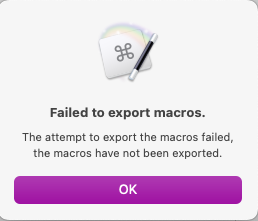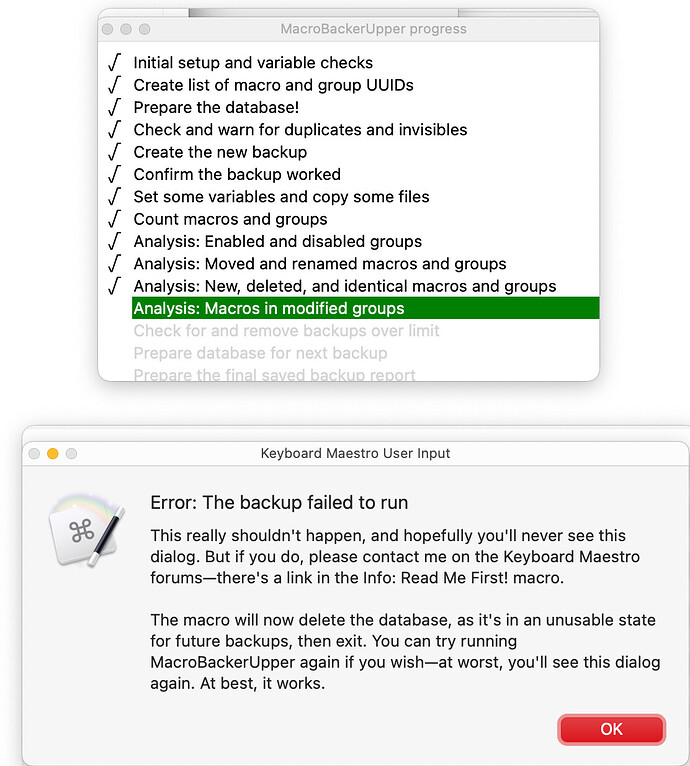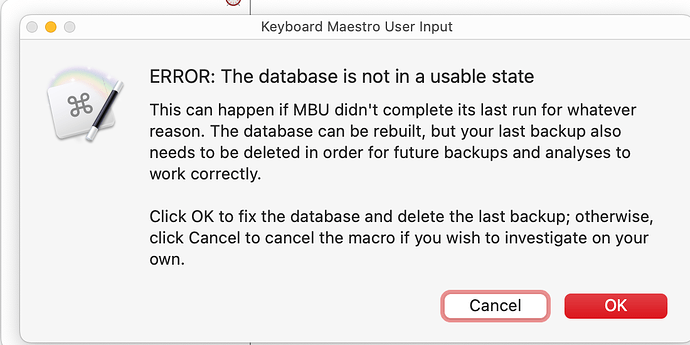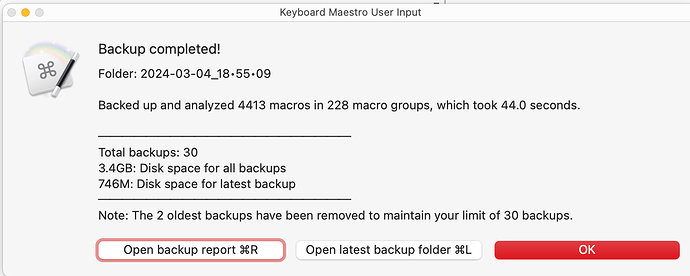If you have the patience, could you give an example based on the above situation where you actually do want to delete everything related to that macro. Basically, you would delete all backups related to that macro ?
thank you
Yes, just as if you had 90 actual copies (i.e. not hard links), if you delete all 90 copies or hard links, then the files are gone.
-rob.
OK. thanks very much
Version 2.9 is out, linked in the first article in this thread or via the in-macro update checker. The only change in this version is how duplicate-named and leading-dot-named macros and groups are handled.
Before, a sample of such items was included in the dialog box. But if you wanted to change all such macros, you had to run the macro a number of times to see all the macros. Version 2.9 now writes the full lists into two files in a temporary folder, and opens that folder when the macro finishes. This should make it much easier to find and change all such names, for all those so inclined.
If you tell MBU to ignore dupes and dots names, then nothing changes—the files aren't created, because the entire routine is skipped.
-rob.
I am so much looking forward to trying this.
Git would be overkill.
Thank you.
Frankly this should be part of KM.
Great macro which I use a few times a week.
Sometimes the macro "freezes" for lack of a better word and I have to manually quit.
Below are 2 failed attempts followed by one successful run.
How sould I troubleshoot this issue ?
thanks very much
——————————————————————————
——————————————————————————
Is there anything that looks relevant in the log file?
-rob.
Thanks very much for this superb macro which I use many times a week.
I noticed a 267 GB snapshot (purgeable space) which appeared on my hard drive and which was not explained by Mac OS Ventura, not time machine nor carbon copy cloner or any other app. I was wondering, based on if it could be related to this macro which if I understand correctly uses snapshots to save space.
thanks very much
The macro uses symbolic links, not APFS snapshots. I don't se any way that the macro could create anything like that at all—it just creates symbolic links in Terminal.
Where on the drive is that 267GB file?
-rob.
How do you mean "not explained"? Appeared where? And how did you notice it?
OK, so it's not MacroBackerUpper. thank you
no location that I could ascertain.with Daisy Disk. Purgeable space.
space on my primary drive ↓
by adding up the usual suspect namely time machine and CCC
Which still leaves sleep images, caches, temporary system files, swap, stuff other apps write out on a temporary basis, and probably a bunch of other stuff. I've only got 8GB of TM snapshots here, but the Finder is showing 27GB purgeable.
If it is a snapshot you should be able to view it in Disk Utility by making sure "Show APFS Snapshots" is selected in the "View" menu and then selecting your data volume (the startup volume will only have OS update snapshots, if any).
FANTASTIC TIP !!!! At last a solution for an irritant that has been pestering me for years which was to list snapshots (easy with terminal) WITH THEIR SIZE. Between my post and your answer, I had deleted the purgeable space with Clean My Mac, there are other snapshots I can see.
So thanks very much.!
yes. Clean My Mac can see and deal with all that. I was following the latest take control book about mac problem solving by @joekissell
I found the following article and app by The Eclectic Light Company useful. The app is for expert users like yourselves, but the section on purgeable space is very useful for me.
I received these in the log.
OS 15.0
2024-10-05 20:00:00 Execute macro “•main | MacroBackerUpper” from trigger At 8:00 PM every day
2024-10-05 20:00:00 Variable “KMVAR_ZIP__ScriptResults” excluded from environment to ensure the environment is not too large
2024-10-05 20:00:00 Variable “KMVAR_Start_Now_Comp” excluded from environment to ensure the environment is not too large
2024-10-05 20:00:29 Action 15603653 timeout exceeded. Macro “•main | MacroBackerUpper” cancelled (while executing Activate Keyboard Maestro).
I downloaded the current version.
Deleted my existing macro.
Now I get this prompt

and this is in the error log.
2024-10-07 10:19:54 Execute macro “•main | MacroBackerUpper” from trigger Editor
2024-10-07 10:19:54 GetProcessForPID(16047) failed with -600 for <KBMRunningApplication “Keyboard Maestro” <0x600003a944d0> pid=16047 bid=com.stairways.keyboardmaestro.editor Abht>, using cached version
2024-10-07 10:20:13 Window SetSizeA <AXUIElement 0x600000028fc0> {pid=16047} resulted in an error -25200
2024-10-07 10:20:13 Window SetSizeB <AXUIElement 0x600000028fc0> {pid=16047} resulted in an error -25200
2024-10-07 10:20:14 Window SetSizeA <AXUIElement 0x600000028fc0> {pid=16047} resulted in an error -25200
2024-10-07 10:20:14 Window SetSizeB <AXUIElement 0x600000028fc0> {pid=16047} resulted in an error -25200
2024-10-07 10:20:51 Log: MBU old file not found, no link made: ___ . test macros ___ . -> _Recent Folders List
2024-10-07 10:20:51 Log: MBU old file not found, no link made: ___ . test macros ___ . -> _Recent Folders Lister K0288
2024-10-07 10:20:51 Log: MBU old file not found, no link made: z Ex From JM -> [CB] How to Detect When Clipboard Has Changes [Example]
2024-10-07 10:20:51 Log: MBU old file not found, no link made: z_experiment_km10 = EKM -> [EKM] Prompt List as Context Menu Demo
2024-10-07 10:20:51 Log: MBU old file not found, no link made: z Various 'Global' macros and safeties -> [KM] Reveal Macro and Group From UUID
2024-10-07 10:20:52 Log: MBU old file not found, no link made: z KTB ⇧⌃⌥⌘ Button 2 -> 01 Calculator
2024-10-07 10:20:52 Log: MBU old file not found, no link made: z Texts Master -> 01)----------Clients----------
2024-10-07 10:20:52 Log: MBU old file not found, no link made: CPU GWL_Office_02 -> 01)Countdown- (toggle) (for export)
2024-10-07 10:20:52 Log: MBU old file not found, no link made: Finder Palette -> 01)Get 1 Selected Item Path from Finder TK K0159
2024-10-07 10:20:52 Log: MBU old file not found, no link made: z KTB ⇧⌃⌥⌘ Button 2 -> 02 Count Characters
2024-10-07 10:20:52 Log: MBU old file not found, no link made: z Texts Master -> 02)-
2024-10-07 10:20:53 Log: MBU old file not found, no link made: CPU GWL_Office_02 -> 02)Countdown- (stop) (for export)
2024-10-07 10:20:53 Log: MBU old file not found, no link made: Finder Palette -> 02)Get Selected Items from Finder ORIG sort of
2024-10-07 10:20:53 Log: MBU old file not found, no link made: Finder Palette -> 03)
2024-10-07 10:20:53 Log: MBU old file not found, no link made: z Texts Master -> 03)-
2024-10-07 10:20:53 Log: MBU old file not found, no link made: CPU GWL_Office_02 -> 03)⎯⎯⎯⎯⎯⎯⎯⎯⎯⎯⎯⎯⎯⎯⎯⎯⎯⎯⎯⎯⎯⎯⎯⎯⎯⎯⎯⎯⎯⎯
2024-10-07 10:20:54 Log: MBU old file not found, no link made: z Texts Master -> 04)-
2024-10-07 10:20:54 Log: MBU old file not found, no link made: Finder Palette -> 04)[FINDER] Move Selected Finder Items to Choose Folder [Example] alias
2024-10-07 10:20:54 Log: MBU old file not found, no link made: CPU GWL_Office_02 -> 04)Countdown- Bagel (for export)
2024-10-07 10:20:54 Log: MBU old file not found, no link made: Finder Palette -> 05)
2024-10-07 10:20:54 Log: MBU old file not found, no link made: z Texts Master -> 05)-
2024-10-07 10:20:55 Log: MBU old file not found, no link made: CPU GWL_Office_02 -> 05)Countdown- Coffee (for export)
2024-10-07 10:20:55 Log: MBU old file not found, no link made: z Texts Master -> 06)-
2024-10-07 10:20:55 Log: MBU old file not found, no link made: CPU GWL_Office_02 -> 06)⎯⎯⎯⎯⎯⎯⎯⎯⎯⎯⎯⎯⎯⎯⎯⎯⎯⎯⎯⎯⎯⎯⎯⎯⎯⎯⎯⎯⎯⎯
2024-10-07 10:20:55 Log: MBU old file not found, no link made: Finder Palette -> 06)Change - Append Filenames in Current Folder
2024-10-07 10:20:55 Log: MBU old file not found, no link made: z Texts Master -> 07)-
2024-10-07 10:20:56 Log: MBU old file not found, no link made: Finder Palette -> 07)Change - Append Rename MASTER Filenames Files Pictures in a Selectable Folder MASTER
2024-10-07 10:20:56 Log: MBU old file not found, no link made: CPU GWL_Office_02 -> 07)Countdown- KM progress bar (caller) (for export)
2024-10-07 10:20:56 Log: MBU old file not found, no link made: z Texts Master -> 08)----------Candidates----------
2024-10-07 10:20:56 Log: MBU old file not found, no link made: CPU GWL_Office_02 -> 08)Countdown- KM progress bar (subroutine) (for export)
2024-10-07 10:20:56 Log: MBU old file not found, no link made: Finder Palette -> 08)Finder→Rename Sequentially Number Selected GOOD
2024-10-07 10:20:57 Log: MBU old file not found, no link made: z Texts Master -> 09)Form-Photo-ID
2024-10-07 10:20:57 Log: MBU old file not found, no link made: Finder Palette -> 09)Remove up to third occurance of - in string
2024-10-07 10:20:57 Log: MBU old file not found, no link made: Finder Palette -> 10)
2024-10-07 10:20:57 Log: MBU old file not found, no link made: z Texts Master -> 10)Next Steps 4 Candidate
2024-10-07 10:20:57 Log: MBU old file not found, no link made: z Texts Master -> 11)Not sure if working
2024-10-07 10:20:58 Log: MBU old file not found, no link made: Finder Palette -> 11)zz Hide Finder Palette
2024-10-07 10:20:58 Log: MBU old file not found, no link made: z Texts Master -> 12)Resume - We'll take a look
2024-10-07 10:20:58 Log: MBU old file not found, no link made: z Texts Master -> 13)-
2024-10-07 10:20:58 Log: MBU old file not found, no link made: z Texts Master -> 14)----------Misc----------
2024-10-07 10:20:58 Log: MBU old file not found, no link made: z Texts Master -> 15)-
2024-10-07 10:20:59 Log: MBU old file not found, no link made: z Texts Master -> 16)----------Services----------
2024-10-07 10:20:59 Log: MBU old file not found, no link made: z Texts Master -> 17)-
2024-10-07 10:20:59 Log: MBU old file not found, no link made: Subroutines -> 47)[MG-SUBRT] Show countdown using progress bar K0313
2024-10-07 10:20:59 Log: MBU old file not found, no link made: z Apple News -> Back
2024-10-07 10:20:59 Log: MBU old file not found, no link made: TV -> Back
2024-10-07 10:21:00 Log: MBU old file not found, no link made: CPU GWL_Office_02 -> Calendar Grab K0247
2024-10-07 10:21:00 Log: MBU old file not found, no link made: z EXAMPLE Checkboxes in Floating Palette -> Checkbox 1
2024-10-07 10:21:00 Log: MBU old file not found, no link made: z EXAMPLE Checkboxes in Floating Palette -> Checkbox 2
2024-10-07 10:21:00 Log: MBU old file not found, no link made: z EXAMPLE Checkboxes in Floating Palette -> Checkbox 3
2024-10-07 10:21:00 Log: MBU old file not found, no link made: zz_Macro by Name -> Countdown Timer Display
2024-10-07 10:21:01 Log: MBU old file not found, no link made: zz_Macro by Name -> Countdown Timer with Task
2024-10-07 10:21:01 Log: MBU old file not found, no link made: z_Test Group -> Custom HTML Prompt Macro List K0031
2024-10-07 10:21:01 Log: MBU old file not found, no link made: z_Test Group -> Custom KM Macro List - Close Window
2024-10-07 10:21:01 Log: MBU old file not found, no link made: z EXAMPLE MACROS for Forum -> EXAMPLE Persistent Prompt Dialog for Setting Variables Version1
2024-10-07 10:21:01 Log: MBU old file not found, no link made: z Quicktime Player -> Fastforward QuickTime Player 10 Seconds
2024-10-07 10:21:02 Log: MBU old file not found, no link made: TV -> FF 10
2024-10-07 10:21:02 Log: MBU old file not found, no link made: z Various 'Global' macros and safeties -> Get Selected Macro UUID
2024-10-07 10:21:02 Log: MBU old file not found, no link made: z Various 'Global' macros and safeties -> Get Selected Macro UUID DEMO
2024-10-07 10:21:02 Log: MBU old file not found, no link made: z Various 'Global' macros and safeties -> Gmail Regular_Email Ref
2024-10-07 10:21:02 Log: MBU old file not found, no link made: z Publish to Forum Group -> Harvest LinkedIn info ORIG
2024-10-07 10:21:03 Log: MBU old file not found, no link made: z Publish to Forum Group -> Harvest LinkedIn info TK Edit
2024-10-07 10:21:03 Log: MBU old file not found, no link made: Splashtop -> Hide
2024-10-07 10:21:03 Log: MBU old file not found, no link made: Splashtop -> Hide Splashtop
2024-10-07 10:21:03 Log: MBU old file not found, no link made: z Ex From JM -> Increment Number [JMichaelTX]
2024-10-07 10:21:03 Log: MBU old file not found, no link made: Safari SteerMouse -> Kens Scroll Down ⌥⌘ - Opt Com - Archive Gmail K0034
2024-10-07 10:21:04 Variable “KMVAR_ZIP__ScriptResults” excluded from environment to ensure the environment is not too large
2024-10-07 10:21:04 Variable “KMVAR_Start_Now_Comp” excluded from environment to ensure the environment is not too large
2024-10-07 10:21:04 Log: MBU old file not found, no link made: Safari SteerMouse -> Kens Scroll Up Cnt K0239
2024-10-07 10:21:04 Log: MBU old file not found, no link made: Bookmarks -> KMForum
2024-10-07 10:21:04 Log: MBU old file not found, no link made: Bookmarks -> KMManual
2024-10-07 10:21:04 Log: MBU old file not found, no link made: z TextWrangler -> Open in New Window
2024-10-07 10:21:04 Log: MBU old file not found, no link made: z Various 'Global' macros and safeties -> Open Logs File
2024-10-07 10:21:04 Log: MBU old file not found, no link made: KM Subroutines -> Prompt With List (HTML)
2024-10-07 10:21:05 Log: MBU old file not found, no link made: KM Subroutines -> Prompt with List (HTML) - Example Caller
2024-10-07 10:21:05 Log: MBU old file not found, no link made: CPU GWL_Office_02 -> Reconnect Count
2024-10-07 10:21:05 Log: MBU old file not found, no link made: CPU GWL_Office_02 -> Restart Splashtop gwl_office_02 gwl_office_02 K0223
2024-10-07 10:21:05 Log: MBU old file not found, no link made: CPU GWL_Office_02 -> Restart Splashtop gwl_office_02 muffetta_krueger K0218
2024-10-07 10:21:05 Log: MBU old file not found, no link made: z Various 'Global' macros and safeties -> Reveal Macro Group
2024-10-07 10:21:06 Log: MBU old file not found, no link made: z Quicktime Player -> Rewind QuickTime Player 10 Seconds
2024-10-07 10:21:06 Log: MBU old file not found, no link made: z Quicktime Player -> Rewind QuickTime Player 10 Seconds new 12_26_22
2024-10-07 10:21:06 Log: MBU old file not found, no link made: Safari SteerMouse -> Safari Last Tab - CmdOpCnt Down
2024-10-07 10:21:06 Log: MBU old file not found, no link made: Safari SteerMouse -> Safari Next to Last Tab OR 5 if you want
2024-10-07 10:21:06 Log: MBU old file not found, no link made: z KTB ⇧⌃⌥⌘ Button 2 -> SEO Palette
2024-10-07 10:21:06 Log: MBU old file not found, no link made: JimSUBS -> Show Palette of Macros & Move Mouse 3
2024-10-07 10:21:07 Log: MBU old file not found, no link made: JimSUBS -> Show Palette of Macros & Move Mouse Make Clipboards 01-10
2024-10-07 10:21:07 Log: MBU old file not found, no link made: JimSUBS -> Show Palette of Macros & Move Mouse Use Clipboards 01-10
2024-10-07 10:21:07 Log: MBU old file not found, no link made: JimSUBS -> sm.⇾MoveMouseToPalette
2024-10-07 10:21:07 Log: MBU old file not found, no link made: JimSUBS -> sm.palette-MoveMouseToPalette
2024-10-07 10:21:07 Log: MBU old file not found, no link made: CPU GWL_Office_02 -> Startup Volume
2024-10-07 10:21:08 Log: MBU old file not found, no link made: Subroutines -> SUB - Activate First Matching Tab
2024-10-07 10:21:08 Log: MBU old file not found, no link made: z EXAMPLE Checkboxes in Floating Palette -> Test Variable Values
2024-10-07 10:21:08 Log: MBU old file not found, no link made: z KTB ⇧⌃⌥⌘ Button 2 -> testing
2024-10-07 10:21:08 Log: MBU old file not found, no link made: z KTB ⇧⌃⌥⌘ Button 2 -> Text Abreviations
2024-10-07 10:21:08 Log: MBU old file not found, no link made: Utilities -> Today's Sunrise and Sunset
2024-10-07 10:21:09 Log: MBU old file not found, no link made: z WhatsApp -> Toggle Finder window Large or Regular
2024-10-07 10:21:09 Log: MBU old file not found, no link made: z Affinity Designer -> Toggle Tools
2024-10-07 10:21:09 Log: MBU old file not found, no link made: z Various 'Global' macros and safeties -> Trigger Option Using Long Press of HotKey [Example]
2024-10-07 10:21:09 Log: MBU old file not found, no link made: z TextWrangler -> Type Command K
2024-10-07 10:21:09 Log: MBU old file not found, no link made: Splashtop -> Wake Computer
2024-10-07 10:21:10 Log: MBU old file not found, no link made: z Desktop Images -> Widgets Hide
2024-10-07 10:21:10 Log: MBU old file not found, no link made: z Desktop Images -> Widgets Show
2024-10-07 10:21:10 Log: MBU old file not found, no link made: z WhatsApp -> Window Frame Restore
2024-10-07 10:21:10 Log: MBU old file not found, no link made: z WhatsApp -> Window Frame Restore 2
2024-10-07 10:21:10 Log: MBU old file not found, no link made: z WhatsApp -> Window Frame Set
2024-10-07 10:21:11 Log: MBU old file not found, no link made: z WhatsApp -> Window Frame Set 2
2024-10-07 10:21:11 Log: MBU old file not found, no link made: z NOTES MAIN OPTIONS (^⌘Z) -> z Dropbox NG NEW NOTE-APPEND TO EXISTING NOTE
2024-10-07 10:21:11 Log: MBU old file not found, no link made: z Various 'Global' macros and safeties -> z Substring(s) of variable
That's a KM error message, not one I generate. When you deleted the macro, did you delete the existing database and global variable, or were you just trying to replace the macro itself?
-rob.
How many macros do you have?
-rob.
I deleted the KM Backups folder.
I didn't delete the database (should I? and how do I do that?)
I didn't delete the global variable? (should I? and which var is that?)
I have 3059 macros
I was trying to just replace the macro because it stopped running. I had it scheduled to run at 7am 1pm and 7pm. It stopped running so I thought I would simply try to re-install the macro.
I took all of my custom editing out of it.
It doesn't matter what I need to do... I can do it, just to get it running again correctly


